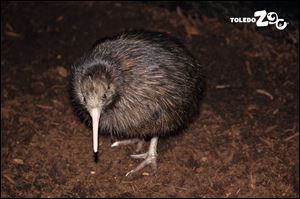
Rare bird born at the Toledo Zoo
2/7/2013
Female North Island brown kiwi chick hatched on January 12 at the Toledo Zoo. This is a first for the Zoo's Avian Breeding Center (ABC), an off-exhibit facility dedicated to breeding rare and endangered birds. Zoo staff is hand-rearing the chick, which as a precocial species was relatively mature and mobile soon after hatching.
One of the Toledo Zoo's newest residents is a female North Island brown kiwi chick.
The chick hatched Jan. 12 in the zoo’s Avian Breeding Center (ABC), an off-exhibit facility dedicated to breeding rare and endangered birds.
Eight zoos in the U.S. and 17 zoos worldwide exhibit the animals, according to Toledo Zoo officials, and few zoos outside New Zealand have successfully hatched kiwi. Through an international species survival plan, zoos worldwide are working together to preserve this species, which is endangered with decreasing populations in the wild.
The Columbus Zoo provided the Toledo Zoo with a fertilized egg in December, 2012, and aviary staff from both zoos worked together throughout the 73-day incubation. Kiwi chicks have the longest incubation period of any bird species, followed by an unusually long hatching process which often lasts several days (the zoo’s kiwi chick took five days to complete hatching).
Public exhibit details have not been finalized but the chick is expected to be a part of the Wild Walkabout exhibit, scheduled to open May 24 which will feature the animals of Australia and surrounding regions.
Kiwi are nocturnal, flightless birds native to New Zealand. In the wild, kiwi were once widespread in New Zealand, but today populations are isolated and fragmented. According to information from the International Union for Conservation of Nature and Natural Resources (IUCN), wild kiwi populations are estimated between 25,000 and 30,000 birds, with declines of 90 percent or more over the last century.
Some kiwi characteristics seem more mammal-like than bird-like. They have a keen sense of smell (rare among birds), good hearing and whiskery feathers around their face. They are also the only bird with nostrils at the end of their beak, and females lay the largest egg of any bird in the world, in relation to their size.